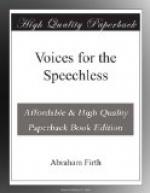In what distant deeps or skies
Burnt the fire of thine eyes?
On what wings dare he aspire?
What the hand dare seize the
fire?
And what shoulder and what
art
Could twist the sinews of
thy heart?
And, when thy heart began
to beat,
What dread hand forged thy
dread feet?
What the hammer? what the
chain?
In what furnace was thy brain?
What the anvil? What
dread grasp
Dare its deadly terrors clasp?
When the stars threw down
their spears,
And watered heaven with their
tears,
Did He smile his work to see?
Did He who made the lamb make
thee?
Tiger, tiger, burning bright
In the forests of the night,
What immortal hand or eye
Dare frame thy fearful symmetry?
WILLIAM BLAKE.
* * * * *
VALUE OF ANIMALS.
Nobody doubts their general value, as nobody doubts the value of sunlight; but a more practical appreciation may be felt of their moneyed value if we look at that aspect of the question in some of its details.
We quote from a hand-book published for the South Kensington Museum:—
“CLASS I.—Animal Substances employed for Textile Manufactures and Clothing. Division I. Wool, Mohair, and Alpaca. Division II. Hair, Bristles, and Whalebone. Division III. Silk. Division IV. Furs. Division V. Feathers, Down, and Quills. Division VI. Gelatin, Skins, and Leathers.
“CLASS II.—Animal Substances used for Domestic and Ornamental Purposes. Division I. Bone and Ivory. Division II. Horns and Hoofs. Division III. Tortoise-shell. Division IV. Shells and Marines. Animal Products for Manufacture, Ornaments, etc. Division V. Animal Oils and Fats.
“CLASS III.—Pigments and Dyes yielded by Animals."—Division I. Cochineal and Kermes. Division II. Lac and its applications. Division III. Nutgalls, Gall Dyes, Blood, etc. Division IV. Sepia, Tyrian Purple, Purree, etc.
“CLASS IV.—Animal Substances used in Pharmacy and in Perfumery." Division I. Musk, Civet, Castorem, Hyraceum, and Ambergris. Division II. Cantharides, Leeches, etc.
“CLASS V.—Application of Waste Matters. Division I. Entrails and Bladders. Division II. Albumen, Casein, etc. Division III. Prussiates of Potash and Chemical Products of Bone, etc. Division IV. Animal Manures—Guano, Coprolites, Animal Carcases, Bones, Fish Manures, etc.”
From a table of the value of imports of animal origin brought into the United Kingdom in the year 1875, we take a few items:—
“Live animals, L8,466,226. Wool of various kinds, L23,451,887. Silk, manufactures of all kinds, L12,264,532. Silk, raw and thrown, L3,546,456. Butter, L8,502,084. Cheese, L4,709,508. Eggs, L2,559,860. Bacon and hams, L6,982,470. Hair of various kinds, L1,483,984. Hides, wet and dry, L4,203,371. Hides, tanned or otherwise prepared, L2,814,042. Guano, L1,293,436. Fish, cured or salted, L1,048,546.”




